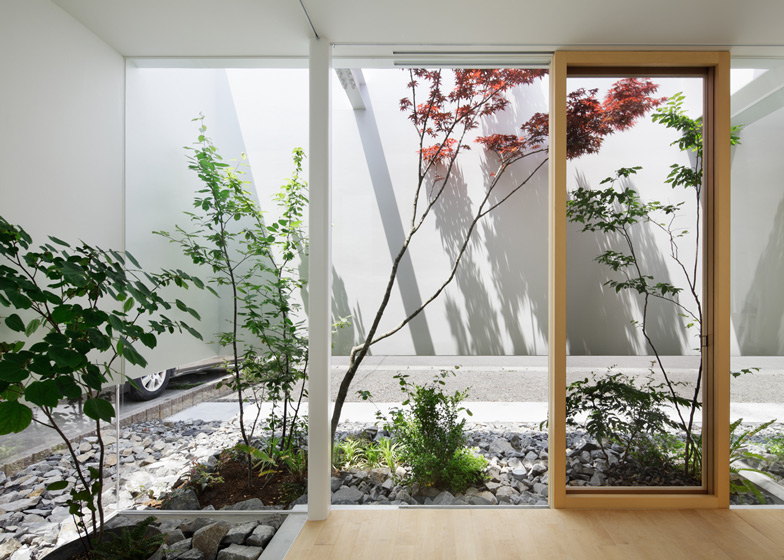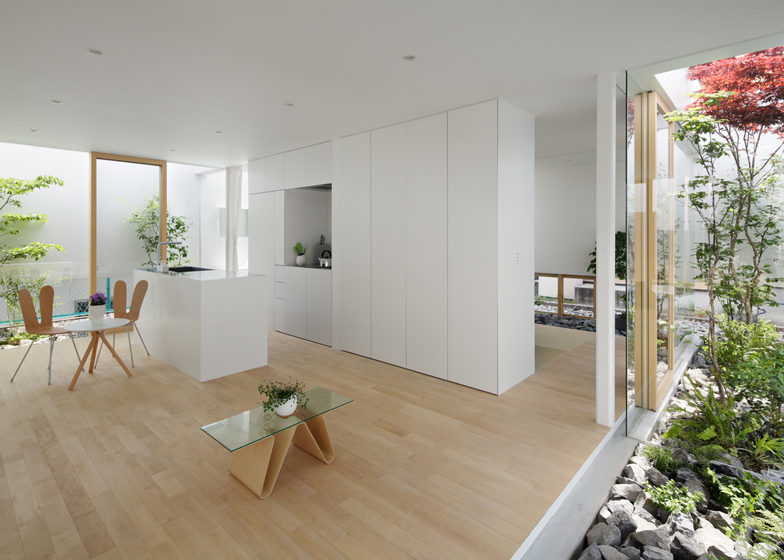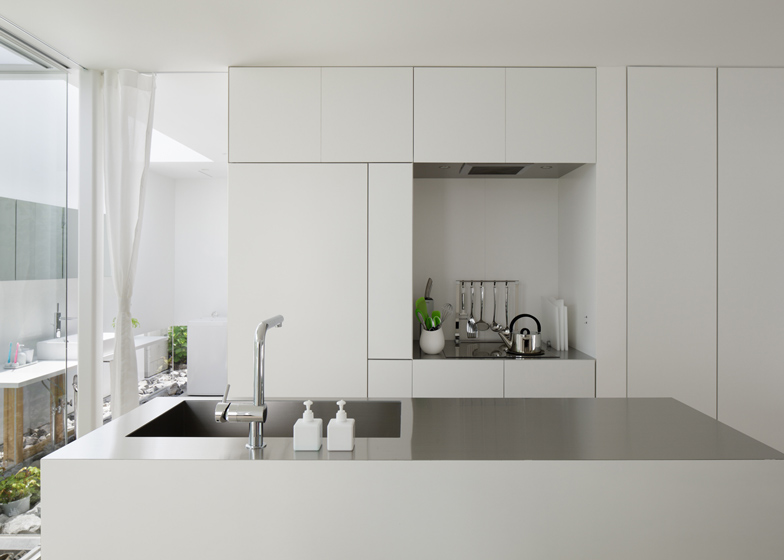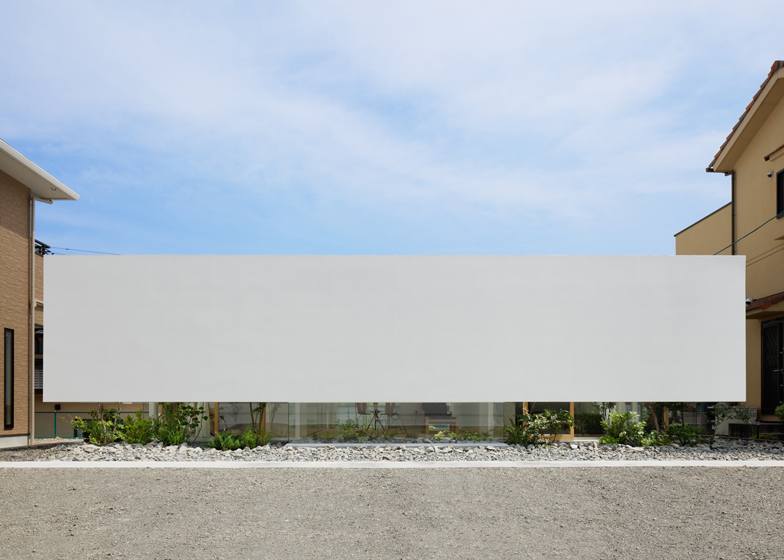A rock garden filled with trees and shrubs is sandwiched between glazed rooms and floating windowless walls at this house in Japan by mA-style Architects (+ slideshow).
Japanese studio mA-style Architects designed the house for a residential site in Fujieda, Sizuoka Prefecture. The architects felt that residents would be better off without a view of their surroundings, so they designed an insular house with a private garden.
Named Green Edge House, the residence is surrounded on all sides by the narrow garden and glazed walls to allow residents to open every room out to the greenery.
"At first we imagined a house with an inner courtyard. However, indoor privacy is not kept in the architecture around the courtyard," explained architects Atushi and Mayumi Kawamoto.
"The transparency of the glass weakens consciousness of a partition between inside and outside. Then the green edge becomes a vague domain without a border," they added.
A blank white wall encases the house and garden, but hovers 65 millimetres above the floor so that daylight can filter into the house without compromising residents' privacy.
As they chose not to add a courtyard, the architects positioned the living room and kitchen at the centre of the house, with a bedroom and entrance on one side, and a Japanese room and bathroom on the other.
The toilet and washbasin sit beyond the perimeter of the other rooms, so residents have to venture into the garden to use them.
Atushi and Mayumi Kawamoto founded mA-style Architects in 2004. Other projects by the duo include a house where rooms are contained inside two-storey boxes and a residence that points outwards like a giant rectangular telescope.
Photography is by Makoto Yasuda, Nacasa & Partners.
Here's a longer description from mA-style Architects:
Ryokuen no Su (Green Edge House)
Design Plan
There was the building site on a gently sloping hill. It is land for sale by the lot made by recent land adjustment here. The land carries the mountains on its back in the north side and has the rich scenery which can overlook city in the south side. However, it was hard to feel the characteristic of the land because it was a residential area lined with houses here. Consideration to the privacy for the neighbourhood was necessary in a design here because it was a residential area.
Therefore at first we imagined a house with an inner court having a courtyard. However, indoor privacy is not kept in the architecture around the courtyard. In addition, light and the air are hard to circulate, too. Therefore we wanted to make a house with an inner court having a vague partition.
At first we float an outer wall of 2,435mm in height 800mm by Chianti lever from the ground. We make a floating wall by doing it this way. While a floating wall of this simple structure disturbs the eyes from the neighbourhood, we take in light and air. A green edge is completed when we place trees and a plant along this floating wall. That's why we called the house "Green Edge". The green edge that was a borderland kept it intact and located a living room or a bedroom, the place equipped with a water supply for couples in the centre of the court. Then a green edge comes to snuggle up when in the indoor space even if wherever. In addition, we planned it so that nature could affect it with a person equally by assuming it a one-story house.
A green edge and the floating wall surrounded the house, but considered it to connect space while showing an internal and external border by using the clear glass for materials. The transparency of the glass weakens consciousness of a partition between inside and outside. Then the green edge becomes a vague domain without a border. The vagueness brings a feeling of opening in the space. In addition, the floating obstacle that made the standard of a body and the life function in a standard succeeds for the operation of the eyes of people.
It is like opening, and a green edge and the floating wall produce space with the transparency while being surrounded. The space changes the quality with the four seasons, too. This house where the change of the four seasons was felt with a body became the new house with an inner court which expressed the non-functional richness.
The Green Edge House does not change the inside and outside definitely.
There is the approach in migratory of green edge and the floating wall. The green edge along the floating wall is the grey area that operated space and a function from a human physical standard and the standard of the life function. We arrange the opening to a physical standard. Act in itself to pass through the floating wall becomes the positioning of the approach as psychological recognition.
In the Green Edge House, various standards make mutual relations each and operate space. For example, as the human physical dimension, standing is 1500-1800mm, and sitting is 820-990mm. On the other hand, as the human working dimension, 750-850mm on the desk, and 730-750mm in the washstand are normally scale. From the module that such a human physical standard and the standard of the life function, floating wall was set with 650mm from the floor, 800mm from the ground.
By doing so, we created the domains where the eyes of the people does not cross of inside and outside. It leads to a feeling of opening for the living people. The floating wall shows an internal and external border. On the other hand, transparency of the glass weakens internal and external difference. With the operation of the standard, and it raises excursion characteristics not to toe the mark.
The Green Edge House is the house which was rich in the variety that balance of the space was planned by a building and a physical standard.
Location: Fujieda – City Sizuoka Japan
Date of Completion: December 2012
Principal Use: House
Structure: steel construction
Site Area: 200.90m2
Total Floor Area: 73.01 m2
Structural Engineer: Nakayama Kashiro
Exterior Finish: Fibre reinforced plastic waterproofing
Floor: Birch wood flooring
Wall: cloth
Ceiling: cloth




